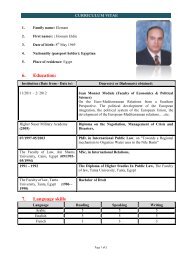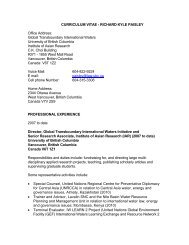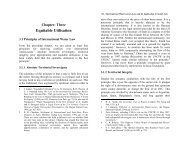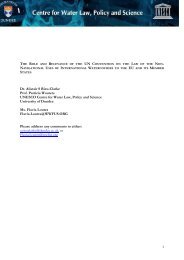Upreti, Trilochan, International Watercourses Law and Its Application ...
Upreti, Trilochan, International Watercourses Law and Its Application ...
Upreti, Trilochan, International Watercourses Law and Its Application ...
You also want an ePaper? Increase the reach of your titles
YUMPU automatically turns print PDFs into web optimized ePapers that Google loves.
54 / <strong>International</strong> <strong>Watercourses</strong> <strong>Law</strong> <strong>and</strong> <strong>Its</strong> <strong>Application</strong> in South Asia Development <strong>and</strong> Codification of <strong>International</strong> <strong>Watercourses</strong> <strong>Law</strong> / 55A United Nation's study in 1978 has showed that there are 261international rivers. 95 With the break up of the Soviet Union<strong>and</strong> former Yugoslavia, the number has escalated further, <strong>and</strong>there are more than 300 treaty agreements regarding theallocation <strong>and</strong> sharing of such waters. Are there the samenumber of practices <strong>and</strong> principles developed so far? Theanswer is obviously no; it is not possible to enunciate a newprinciple in each agreement. As far as the state practices areconcerned, two principles have been developed, the principlesof 'equitable utilisation' <strong>and</strong> ‘no harm rule’. They are acceptedin most of the state practices as the basic norms of anynegotiation. 96 It is, therefore, argued that the increasedinteraction <strong>and</strong> interdependency of states has forced IWL to bemore responsive to the conflicting interests of co-riparian. 972.7 State PracticeIt is appropriate to examine some of the state practices that aresignificant to the development of this area. The Conventionbetween Sweden <strong>and</strong> Norway on Certain Questions Relating tothe <strong>Law</strong> on <strong>Watercourses</strong>, 1929 stipulates stringent conditionson alteration of the flow of waters; it requires prior agreementor consent of the other riparian state before any alteration offlow of the waters can be made. 98 As demonstrated earlier,from the observations of case law analysed above, states areobliged to use an IWC in such a way that shall not cause any95 Register of <strong>International</strong> Rivers, (1978) UN, Geneva, p. 3.96 Supra note 7 p. 215-230; also see S.C. McCaffrey & M. Sinjela, “The1997 United Nations Convention on <strong>International</strong> <strong>Watercourses</strong>”(1998) in 92 AJIL, p. 99.97 Moermond III, & J. O. Shirley Erickson, "A Survey of the<strong>International</strong> <strong>Law</strong> of Rivers" (1987) in 16 DJIL&P, pp. 139-159.98 Supra note 36, p. 56. Article 62 of the (1929) treaty between Sweden<strong>and</strong> Norway provides that without consent any diversion is notallowed. This provision, however, was not applied in the Lake Lanouxjudgement as evaluated earlier.detrimental or adverse affects to other riparian states. Thenotion, in fact, has become the rule of customary internationallaw as seen above in Gavcikovo-Nagymaros judgment <strong>and</strong>Article 5 of the UNCIW.A similar arrangement in the treaty of 1933 between Brazil <strong>and</strong>Uruguay provides half of the waters to each party. If anyutilisation of water may cause an appreciable <strong>and</strong> permanentalteration in the rate of flow of a watercourse running along orintersecting the frontier, the state desirous of such utilisationshall not carry out the necessary work until it has concluded anagreement with the other state. 99 It must, therefore, be borne inmind that through co-operation, negotiation <strong>and</strong> agreement anyproblems can be settled <strong>and</strong> conflicts resolved to thesatisfaction of conflicting states. If we carefully examine theprovisions of water sharing treaties, stipulations of suchconditions are common in most of the instruments.Such prohibition has become an indispensable part ofmultilateral conventions. The General Convention Relating tothe Development of Hydraulic Power Affecting More than oneState, 1923, Article 4, limits the right of a co-riparian in the useof waters flowing through its territory by requiring the consentof the other co-riparian which may have caused serious injurywith prejudice to any other contracting state. 100 However, itshould not be inferred that these provisions are against theconcept of equitable utilisation, because the concept impliesthat if a use inflicts injury or harm, this itself falls in thecategory of unreasonable <strong>and</strong> inequitable utilisation.Eventually, the instrument corresponds to both principles ofequitable utilisation <strong>and</strong> the no harm rule. The Seventh<strong>International</strong> Conference of American States 1933 alsopronounced the principle of limited sovereignty in consequenceof which no state may, without the consent of the other riparian99 Ibid. p. 125.100 Supra note 57, p. 46.












